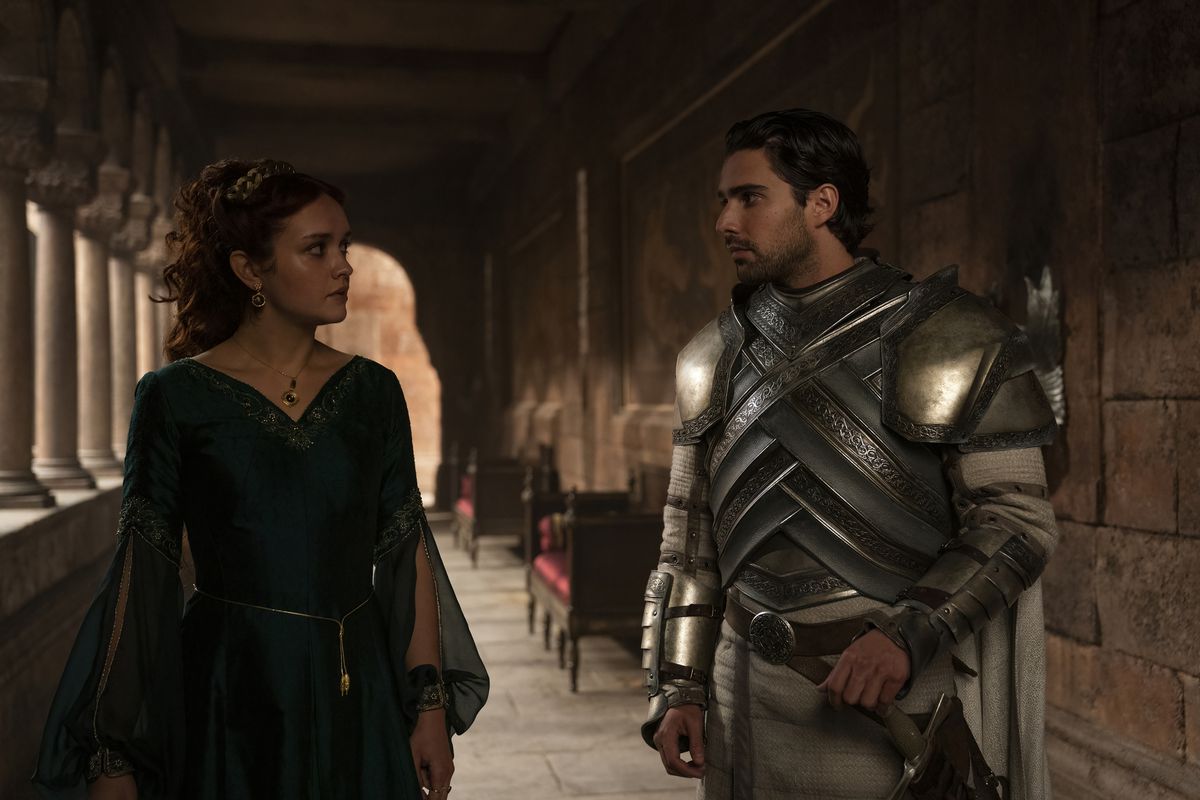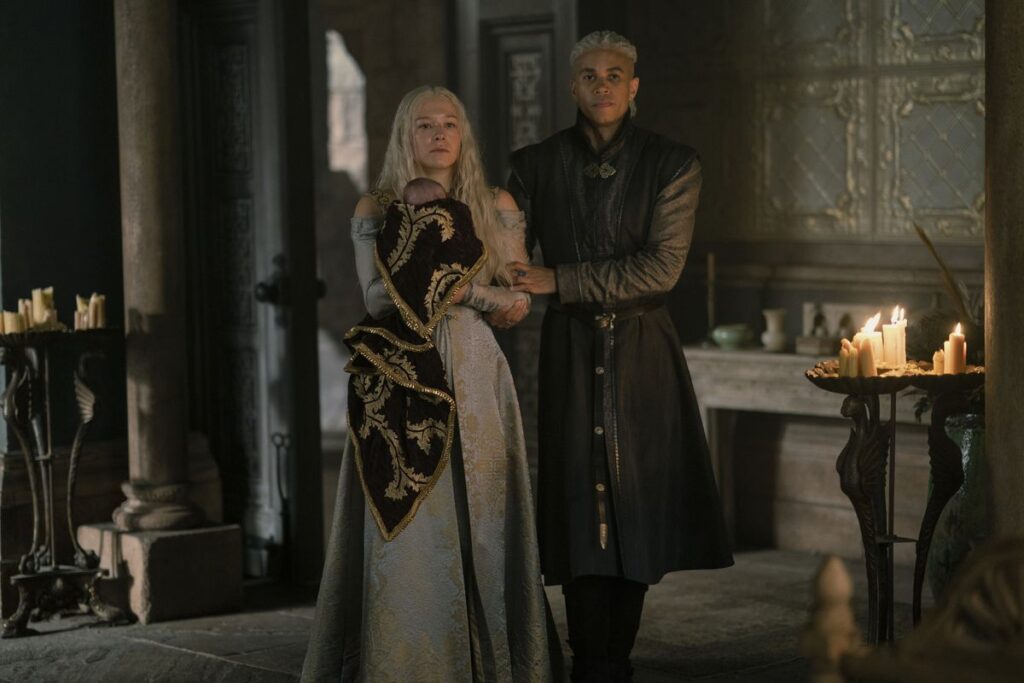One creative decision has been looming over House of the Dragon since the August premiere of the show: A 10-year time jump right in the middle of the show’s first season, one that would mark new actors assuming the lead roles of Rhaenyra Targaryen and Alicent Hightower. With a few exceptions — like those who play the children of Lord Corlys Velaryon (Steve Toussaint), who are each portrayed by three sets of actors throughout the season — Rhaenyra and Alicent are the only two main cast members to swap performers after the time jump. This has made the mid-season decade leap forward feel unusually weighty — and for the most part, House of the Dragon does not make a big deal of it.
This is in keeping with established habits. The epic sweep of House of the Dragon has only been subtly signaled in the show. After on-screen text in the premiere denotes that the series’ events take place “172 years before the birth of Daenerys Targaryen,” House of the Dragon never bluntly nods to the timeline again. Characters denote the passage of time and say how many years it’s been — often for the audience’s benefit — but like in Mad Men, time jumps in this show have been frequent and unremarkable. The time between one episode and the next is simply how long it takes for another interesting thing to happen, be that four days or four years.
So it’s a little underwhelming, if consistent, to see House of the Dragon introduce the new versions of Rhaenyra and Alicent under relatively mundane circumstances. We meet Rhaenyra first (now played by Emma D’Arcy after Milly Alcock’s tenure as young Rhaenyra) in the midst of childbirth. The arrival of her son, Joffrey, is what “The Princess and the Queen” hangs its structure around, as Rhaenyra chooses to forgo resting to take her newborn son around the court.
Photo: Ollie Upton/HBO
This is how we learn the new status quo, which is surprisingly similar to the old one. Viserys (Paddy Considine) survived his dire-seeming collapse from last week and still rules as king, and Alicent (Olivia Cooke taking over for Emily Carey) has settled into her role as queen. The place is bustling with children, as Rhaenyra has two other sons beside Joffrey — none of whom, Alicent notes, look like her husband, Laenor Velaryon (now played by John Macmillan). Alicent’s son Aegon is now a punk-ass teen, and still the heart of Alicent’s long-simmering quiet conflict with Rhaenyra, who remains heir apparent instead of her son.
Without prior knowledge of the Targaryen history that House of the Dragon dramatizes, this feels a bit repetitive. “The Princess and the Queen” comes across as a second pilot, one that sets up the real show. This isn’t necessarily a bad thing; it just means the rest of the series now has to prove that these last five episodes were vital to what’s in store, putting what may be undue weight on things like this cast change.
Putting aside those extant concerns, “The Princess and the Queen” feels like a quiet stage play built to ratchet up tension. Conflicts that have their roots in previous episodes are starting to boil over: Ser Criston (Fabien Frankel) is now Alicent’s loyal stooge, consumed by rage and jealousy after Rhaenyra both spurned him and had children with another Kingsguard knight, Ser Harwin Strong (Ryan Corr). Those children have then been passed off as Rhaenyra’s legitimate sons with Laenor, a royal scandal festering right under everyone’s nose that goes public when Criston insults Harwin and the two come to blows.

Photo: Ollie Upton/HBO
By the end of the episode, Alicent’s cold war turns hot. Speaking with the crafty and manipulative Larys Strong (Matthew Needham), Harwin’s brother and son of the current hand, Lord Lyonel Strong (Gavin Spokes), Alicent rages against Rhaenyra’s flouting of the decorum she has so strongly adhered to, seemingly without consequence. Larys takes this as indirect instruction to create some by offering to spare the lives of convicted criminals if they agree to lose their tongues and do his dirty work — which is setting his family home ablaze to kill his father and brother.
In this new version of House of the Dragon, palace intrigue is still paramount, but its ripples outside of King’s Landing might soon be hard to ignore. As its new leads, Emma D’Arcy and Olivia Cooke take over nigh-seamlessly from their predecessors — although Cooke’s resemblance to Emily Carey is so uncanny, recasting Alicent feels redundant. As an older Rhaenyra, Emma D’Arcy depicts a more resigned version of the crown princess, attempting to maintain a presence in the Small Council while also fulfilling — in her own, scandal-prone way — her duty to produce heirs. In this, Rhaenyra’s recasting feels justified, as the girl who came so close to the power she wanted at a shockingly young age is forced to wait and endure threats to that power well into her womanhood.
Around these two new takes on the central characters, players new and old are reshuffled in a way that is a little disorienting but also animating. Even across the sea in Pentos, Daemon (Matt Smith) finds his self-imposed exile upset when his new wife, Laena Velaryon (now played by Nanna Blondell) self-immolates via dragon fire when she loses her baby in childbirth. House of the Dragon doesn’t seem like it’s being subtle here: We are watching the versions of all these characters that will soon implode and reshape the map of Westeros for the next century.
“The Princess and the Queen” is the kind of TV episode that feels lesser as it’s being watched, but deepens with some distance. It’s an hour of TV that, more than most House of the Dragon episodes thus far, clearly trades Game of Thrones’ sprawl for a more focused study of entropy and the ways in which royal self-preservation is at odds with familial bonds. And it explores this in a pretty nuanced way, as its core conflicts are all the same, just soured with the passage of time until, presumably, everyone will be embroiled in a war they have no hope of understanding. Even the most straightforward of arguments have an edge to them when there are dragons there, lurking beneath everyone’s feet.

